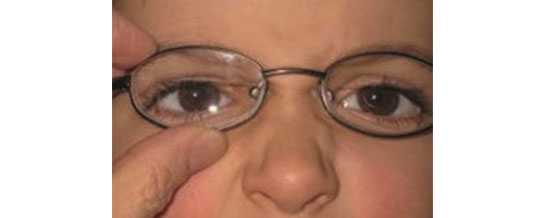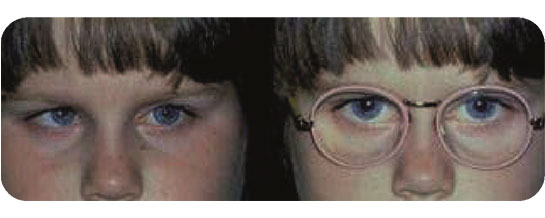Accommodative Esotropia

What is accommodative esotropia?
Accommodative esotropia, or refractive esotropia, refers to eye crossing that is caused by the focusing efforts of the eyes as they try to see clearly.
Children with refractive esotropia are normally farsighted (hyperopic).
This means that the eyes must work harder to see clearly when looking at an object up close. This focusing effort is called accommodation The closer an object is to the eye, the more he/she has to focus to see. A side effect of the focusing effort can be excess convergence (coming together) or crossing of the eyes.
Why is accommodative esotropia a concern in children?
If a child’s eyes cross at an early age, vision will not develop normally. Vision can be permanently reduced in one eye if it is not “used” properly during childhood, and fine depth perception may never develop. If crossing of the eyes is diagnosed and treated early in children, this will help normal eye development. Crossing of the eyes is not a normal response to eye development, especially after the first six months of life.
Do all children with farsightedness have accommodative esotropia?
No. Most children are farsighted but the majority of them do not have any esotropia. The more farsighted a child is, the greater the amount of effort they use and the more likely they are to cross their eyes. Genetics plays a role in determining if children develop esotropia.

How is accommodative esotropia treated?
Treatment for accommodative esotropia includes prescribing eyeglasses or contact lenses to correct your child’s refractive error (hyperopia). Eyeglasses do the work and the eyes can relax their focusing effort. This will reduce the crossing stimulus and the eyes will straighten as they relax. Glasses or contacts which are used to treat accommodative esotropia should be worn all the time.
What happens after my child starts wearing glasses for accommodative esotropia?
Even after your child has been successfully wearing glasses to treat accommodative esotropia, it is still normal for the eyes to continue crossing without the glasses. Crossing may be even more noticeable than it was before your child started wearing glasses.
If the eyes are not straight with glasses on, then binocular vision will not develop properly and other treatments will be needed. Your child’s ophthalmologist (Eye doctor) is the best person to monitor the condition and will update you at follow-up visits. Follow-up exams are important not only to monitor the eye crossing, but also to check for other problems such as amblyopia (vision loss that may affect one or both eyes in young children).
Will my child need surgery?
Surgery is only required if the eye glasses fail to straighten the eyes. Eye muscle surgery (strabismus surgery) may be recommended to help improve the alignment of the eyes. Usually surgery for accommodative esotropia does not eliminate the need for glasses, but can help decrease the amount of crossing that is “left-over” when you child wears glasses. Surgery does not replace the need for glasses.
Why do some children with accommodative esotropia require bifocals?
For some children they will have excessive eye crossing (esotropia), even when wearing the correct glasses to correct their farsightedness (hyperopia). These children may benefit from making the lower, reading area of the eyeglasses “extra strong” in the form of a bifocal lens.
Can children outgrow accommodative esotropia?
Yes, some children can outgrow accommodative esotropia. Your child’s health care provider will be able to better advise you about your child.
If you have any questions or concerns:
Please contact Sidra eye clinic.

